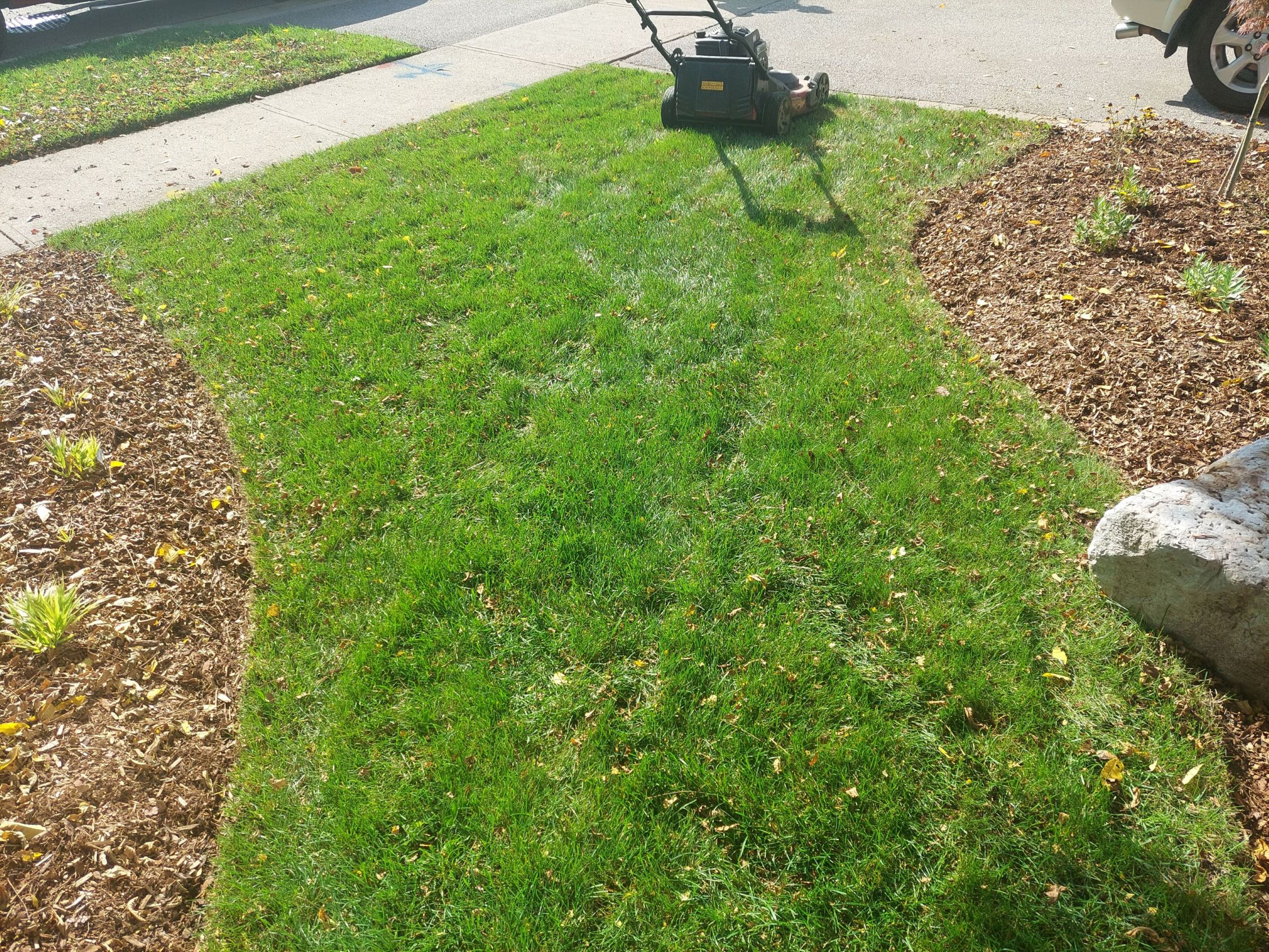Spring Flowering Bulbs
Every spring the landscape wakens with the wonderful colours of spring flowering bulbs. We all know them; tulips, daffodils, crocus…. and so many more. Facebook and Instagram are flooded with beautiful images of bulbs every spring. People make links to the Keukenhof Botanical Gardens showing exactly how wonderful these flowers can be.
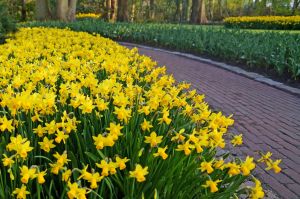
A benefit of using spring flowering bulbs in a landscape is it extends the spring blooming season. Colour will start late winter and can extend until late spring or even early summer. One design strategy we use is to bring all year interest to gardens. We use late and early flowering plants to extend the blooming season and use plants with unique winter interest. Bulbs help us kick the season off right!
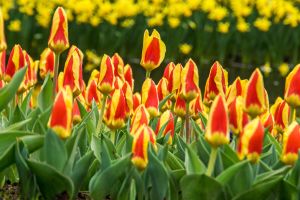
We have the privilege of taking care of some wonderful gardens for our clients. The benefit to us is by using spring flowering bulbs is it extends the spring season allowing us to concentrate on other tasks. Spring is so busy and all our clients (rightfully) want their gardens cleaned up as early as possible. With bulbs flowering, our season is made a little less hectic as we clean those gardens once the bulbs have finished.
It is so easy to have a beautiful spring garden and yet so many people are hesitant to try. Why? I am not sure why… bulbs look expensive and yet they are not. If you look at a bulb we sell to our customer, or one they may buy at a garden centre, they might be $1.00 each for a daffodil or may $10.00 for a flowering onion. On the surface that light seem expensive but you must remember these are perennial plants – coming back year after year. A perennial plant at the same garden centre may be $20.
I think one of the things that worry people is you put all of your effort in planting them and don’t the results of your work until spring. As a landscaper and horticulturist, I find this a little frustrating knowing I can make a beautiful spring garden for our landscape clients.
There are a number of ways to use bulbs. You can plant them as you would annual flowers in nice straight rows like they do in Niagara Falls and Ottawa with tulips. They can be planted in “random” clumps as you may with perennials. Lastly, you can “naturalize” them by planting them randomly in gardens or lawns.
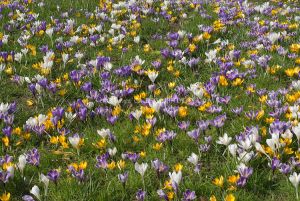
I thought I would spend some time introducing you to some of my favourite bulbs.
Please notice tulips are not on my list. I absolutely love tulips, the problem is so do squirrels. We have lots of issues with squirrels digging up other bulbs as well but tulips seem to have a certain attraction for squirrels.

Tulips perform best when used as an annual plant. Each spring after flowering, remove the tulip plant and bulb. Why? Tulips do not perform well as a perennial plant – they tend to revert to another colour after only a season or two.
Allium atropurpureum – Ornamental Onion
This is a terrific bulb flowering from late spring to early summer. These are excellent massed into a group and in the background of a garden. These attract nectar eating insects. The flowers are about 32” tall. Flowers late spring through early summer.
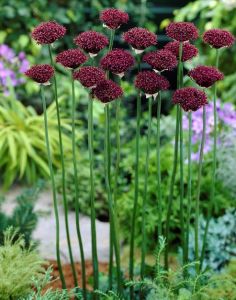
Allium ‘Globemaster’ – Globemaster Ornamental Onion
Globemaster are a stunning flowering onion. These grow about 32” tall but the flowers are 8-10″ across. Fantastic! Use these to make a statement – that statement is “Look at me!”. For an impactful garden plant 3 to 4 bulbs per square foot! These are one of my absolutely favourite bulbs to plant.
There is a garden in Mississauga I admire. They have a plantation of Globemaster planted along a fence. The gardener lets the bulbs go to seed. The planting, now years old, has many different sizes of flowers at different stages of growth. Amazing colour from late spring through early summer.
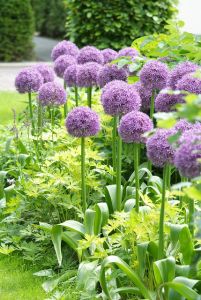
Allium ‘Mount Everest’ – Mount Everest Ornamental Onion
What a beautiful white flower. Blooms from late spring through early summer on 44” stems with flowers being about 6” across. These make a great addition to a spring garden. Plant these about 3 to 4 per square feet.
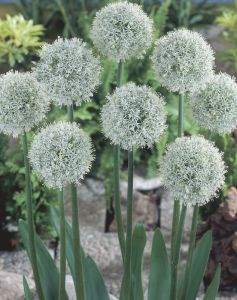
Allium siculum ssp. bulgaricum – Mediterranean Bells
This is an oft underused plant. The flowers droop gracefully. The flowering shape is called an umbel and is made of about 30 individual flowers. This 40” tall flower is showy in late spring.
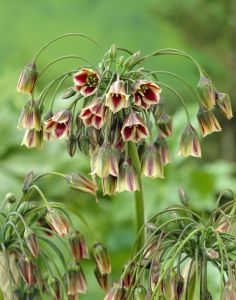
Allium sphaerocephalon – Drumstick Allium
These are a very unique addition to the spring garden. Flowering in very early summer, the Drumstick Allium add a beautiful deep burgundy colour to the garden. These bulbs are great for naturalizing. Plant about 20 bulbs per square foot for the best impact. The flowers are about 24” tall.
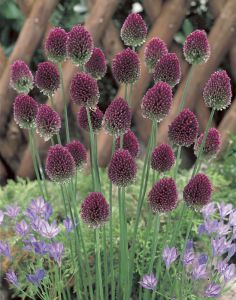
Crocus
Crocus are one of the favourite early spring flowers – perhaps the harbinger of spring itself as they flower from late winter to spring. There are 2 main types of crocus. Species crocus and names varieties. All are great for naturalizing or interplanting in gardens. Some of the named varieties we like are Yellow Mammoth, Barr’s Purple, Jeanne D’Arc (white flowers) and Remembrance (mauve, almost blue).
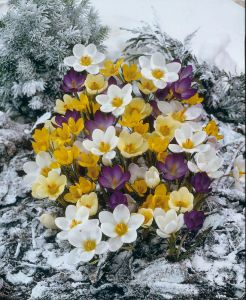
Narcissus are terrific plants. I love the fact squirrels don’t like them. There are so many different types of daffodils available. Daffodils are easily worked into formal gardens, or even naturalized.
Some of the types of Daffs available are based on flower timing; early, mid and late season. Some are based on height, standard size bloom or miniature, colour.
Here are a few of my narcissus…
Stainless
A beautiful white flowering daffodil. This16” beauty flowers mid to late spring. The flower is a large cupped, almost pure white bloom. An excellent addition to the garden.
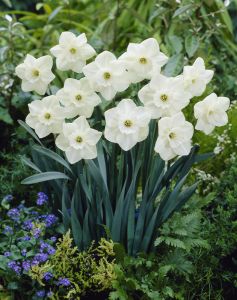
Yellow Cheerfulness
This beauty blooms in early summer on 16” long stems. The double yellow flowers are indeed cheerful!
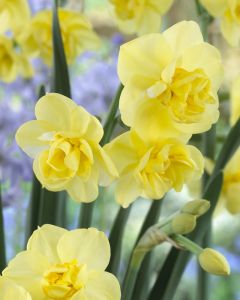
Hawera
Hawera is a heirloom variety. The blooms appear in late spring and are fragrant. This miniature variety has stalks only 12” tall with dainty yellow flowers. This variety is excellent for use in a woodland garden.
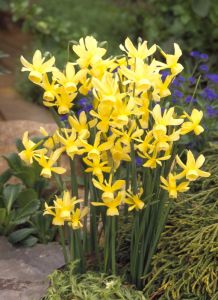
Actaea
This is a very late blooming variety. The late bloomers work well in perennial borders as their leaves will be dying down as other perennials are filling in. Actaea has a beautiful orange centre to the flower. The flower stalks are about 18” tall.
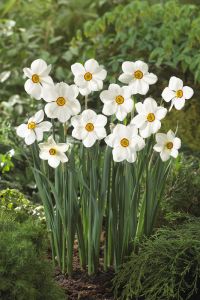
Barret Browning
This is referred to as a “small cupped” daffodil. The centre portion of the flower is the corona and it is cupped shaped so we call it “the cup”. Barret Browning’s cup is orange and the tepals are white – very striking. The flowers are on 16” stalks and appear early to mid spring.
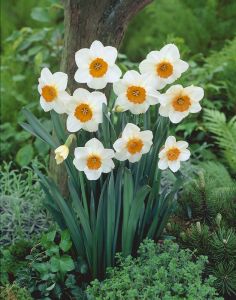
Parisienne
This is referred to as a split corona variety. The cup is divided giving it a very unique look. The corona is orange and almost frilled. The 16” flowers give this plant a mid spring impact.
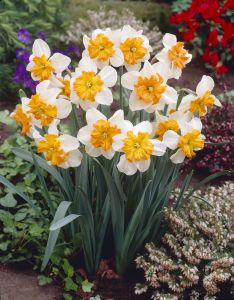
Camassia quamash – Camassia
There are several varieties of camassia available. Quamash is native to southern Canada and the north west United States. Camassia in general are a great plant for developing a focal point. When planted at a density of 8 plants per square foot, they will add a beautiful addition to a perennial border. The 14” tall flowers are dainty yet spectacular.
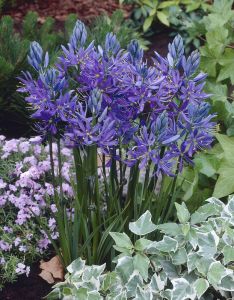
Hyacinth ‘Blue Jacket’
To be honest, it is really difficult to choose just one hyacinth. Hyacinth come in a plethora of colours, blue, white, yellow, pink, red and are fragrant. They add such a welcome splash of fragrance in mid-spring.
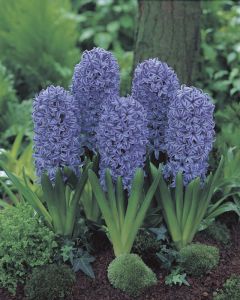
Iris reticulata ‘Harmony’ – Harmony Iris
There are many varieties of dwarf iris but Harmony is unique. These royal blue iris with their yellow markings are beautiful flowers to add to the late winter garden. Not very many people use these bulbs so they add unique colour and texture to a perennial border.
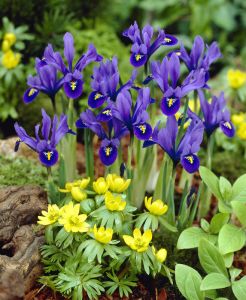
Minor Bulbs
We refer to some flowers as minor bulbs. These plants usually are very diminutive in size but offer a huge impact. We often use these bulbs interplanted among other bulbs, in what we call a woodland garden, naturalized in lawns, to be honest, pretty much anywhere we want a splash of colour late winter through late spring.
Galanthus Elwesii
This is often referred to as Giant Snowdrop. It has larger leaves and flowers than the “normal” snowdrop. When this plant flowers you know spring is on its way as it blooms very early spring.
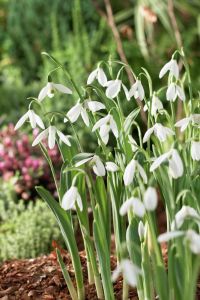
Muscari armeniacum – Grape Hyacinth
These small – 6″ – flowers resemble small bunches of grapes, hence their common name. Flowering mid spring they add a lot to the spring garden. For the best impact they need to be massed using about 15 bulbs per square foot.
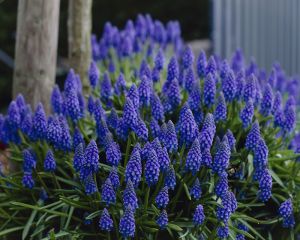
Anemone Blanda – Armenian Anemone
Some people find anemone a challenge to grow. I find that once they are established it is a challenge to get rid of them! The bulbs are small little chunks that look like nothing. There are a few different types of anemone, but blue and white are the most common. These minor bulbs are great anywhere in the garden. We have an ephemeral garden that anemone are featured in. They need to be densely planted, about 24 bulbs per square foot. Squirrels like them so make sure you use a rodent repellant.
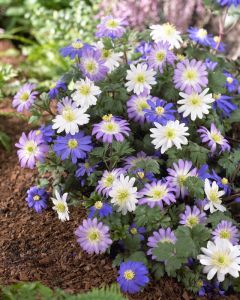
Chionodoxa forbesii – Glory of the Snow
Flowering very early in the spring these beauties get their name honestly. When planted at a density of 20 – 24 bulbs per square foot, these add little splashes of colour throughout the garden or naturalized area. The only grow 6” tall adding to other plants interest as the garden awakens each spring.
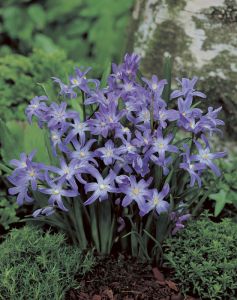
Eranthis hyemalis – Winter Aconite
The first time I remember being impacted by these beautiful yellow flowers was at the Edison Museum in Rochester, New York. There is a stunning European Beech on the property and the entire area under the branches was a blanket of these yellow flowers. I love using winter aconite in our gardens and our landscape clients’ gardens. The bulbs are not always available so I often order from our supplier in January for an October delivery! Plant at about 24 bulbs per square foot.
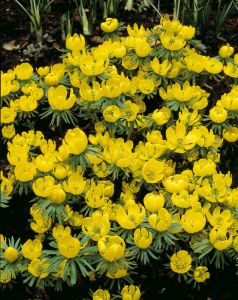
Fritillaria meleagris – Checkered Fritillaria
We usually plant a mix of fritillaria bulbs with colours ranging from creamy white to purple. The 6” flower stalks bear a unique shaped and coloured flower. Plant clumps of these throughout the garden or naturalized area at a density of about 6 per square foot. These bloom mid to late spring.
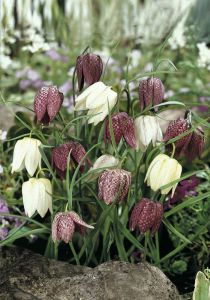
Leucojum ‘Gravetye Giant’ – Snowflake
Leucojum is such a unique flower that when we use it in a client’s garden we are often told people will stop and ask what they are. They flower mis to late spring on stalks about 18” tall. Plant 4 per square foot for the best impact.
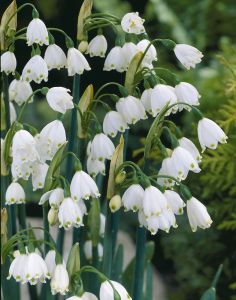
Puschkinia scilloides var libanotica – Striped Squill
This is a subtle early spring flower. I call it subtle as it blends into the other spring colours. Planted 15 per square foot the are excellent for use in any area of the garden. We like using them to naturalize into lawns or woodland gardens.
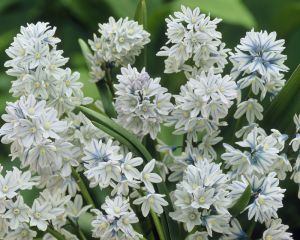
Scilla siberica – Siberian Squill
There are many different types of scilla but we chose to feature Siberian Squill. These blue nodding flowers are a great bulb to add pockets of colour to the early and mid spring garden. Plant at 15 per square foot.
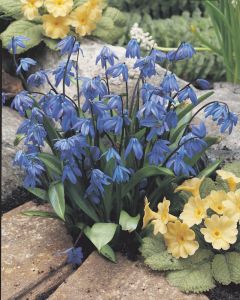
Planting Bulbs
Bulbs are super easy to plant. Most retail packaging has the planting depth on it. If not, bulbs are to be planted 3 times as deep as their narrowest diameter. If a bulb is about 2” across, plant it 6” deep. We use a pelletized compost – available at most garden centres – as we plant to offer some micronutrients. Once the bulbs are planted, water them in well! They are little dormant growth structures and cannot produce roots unless they have adequate moisture.
Rodent Repellant – Those darned squirrels
We have used a blood based product as a rodent repellant. It seems to work well but it has some limitations. Once it is applied it works very well. After being subject to rain or irrigation its potency diminishes. So once you apply it, you need to re-apply every time we have rain or the garden is watered.
Fertilizer
As a landscaper, we take a bit of a holistic approach to our gardens. Depending on the size of the planting we will use a bulk compost or a pelletized compost. The pelletized compost is much easier to use but on larger planting is not as cost effective as using bulk compost or composted manure. If your soil is poor, you should remediate the soil before you do any planting.
Typically we do not use fertilizer on bulbs. We may fertilize the entire garden but that is a “landform” application of a balanced fertilizer.
Pests
I am not sure if I have mentioned this but squirrels are a huge pest of spring flowering bulbs. Other than rodents, there are not many biological pests that affect spring flowering bulbs – at least in our area. Deer can be a nuisance as well.
The absolute worst pest is two legged – yes indeed, us. We don’t water bulbs in properly causing them to remain dormant too long into the autumn. We mow naturalized areas too early removing the plants’ leaves causing them to become weaker and weaker and usually dying.
Just have fun with these beauties. The joy of seeing a splash of colour in a late winter landscape is indescribable.
As usual, please reach out to us if you have any comments or questions!




